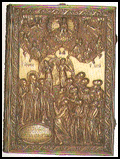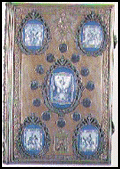 |
| Pict.20. Silver gilt gospel cover with representation of the Ascension of Christ, 1813. |
 |
| Pict.21. Silver gilt gospel cover with representation of the Descent to Hades, 1693. |
 |
| Pict.22. Silver gilt gospel cover with stetharia of enamel and niello. Russian art, 1802. |
|
In the rich collection of silver gilt covers of printed gospels, with their strong baroque style, as it had been incorporated in the
art if the Orthodox East during the late Turkish occupation, we can find signed works of the Cypriot goldsmiths John and George
of 1813 (picture 20) as well as Hadjioanni (S 1043) from the village of Odou (1864).
The gospels from Russia are of a different texture and decoration; they bear multi-coloured enamel stetharia while many precious
and semi-precious stones complete the decoration. Impressive as to its size and weight is the printed bilingual gospel with Greek
(1799) and Slavonic (1796) text. It is a votive offering of the Cretan George Bernardakis (1804). Externally it is bound with wood
planks, silver-and gold-plated, sculpted and carved, belonging to 1802 with the imprint of the Russian workshop that made it.
On the main side it bears five enamel stetharia with the Resurrection of Christ and the Evangelists, embellished with semi-precious
stones.
The Resurrection is encircled by twelve smaller stetharia with scenes from Christ's passion in niello workmanship. At the rear in
the middle in separate relief the Ascension of Christ is represented with eleven stetharia which represent eleven dawn gospel
passages on the Resurrection, also in niello (picture 22). Another cover (1737) of a bilingual Greek-slavonic gospel (1693 edition
of the Metropolis of Hungaro-Wallachia) consists of two one-piece silver plates with engraved decoration in high relief and with
gilded surface. A central representation depicts "the Descent to Hades'' enframed by eighteen rectangular panels which depict
the passion cycle and the Resurrection (picture 21). On the rear side Saint Savvas is depicted with scenes from his life as well
as the Annunciation of the Virgin. This type of cover was usual in the workshops of Transylvania from the end of the 17th century
to the middle of the 18th century and especially at the workshop of Georg May II (1688-1712).
|





